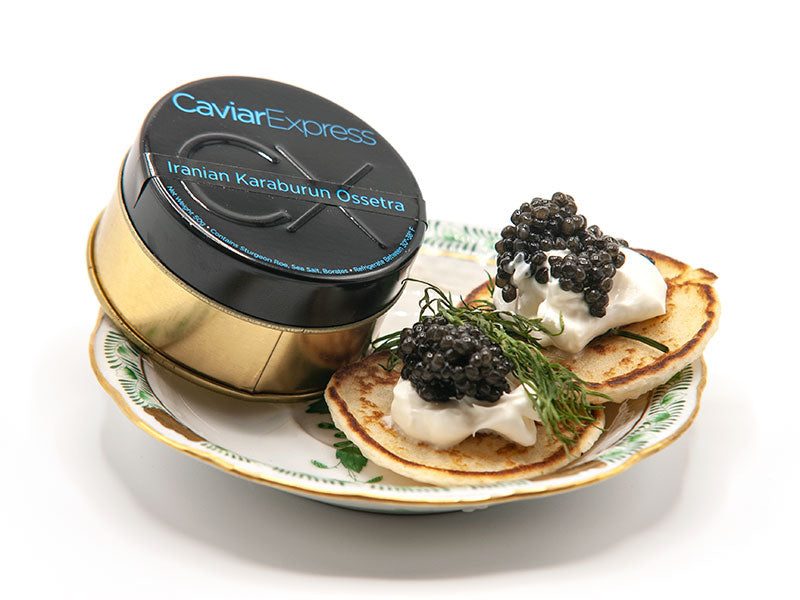
A Guide to Identifying High-Quality Caviar
Share
Caviar, often referred to as "black gold," is a luxurious delicacy that has been enjoyed for centuries by royalty, dignitaries, and epicureans around the world. Derived from the roe of sturgeon fish, caviar's unique taste, texture, and appearance make it one of the most sought-after gourmet foods. However, not all caviar is created equal, and the market can be flooded with inferior products. In this comprehensive guide, we will explore the key factors that will help you identify and savor authentic, high-quality caviar.
One simple way is, of course, order your caviar from Caviar Express. At Caviar Express we only source our caviar from the best sustainable sources, from the most premium species and origin, with the best appearance and color consistency, fantastic texture and size, and luxurious flavor profile.
Depending on the species of sturgeon, area of harvest, and treatment of the eggs after harvest, caviar can vary in texture, flavor, and appearance.
1. Species and Origin
The first step to identifying high-quality caviar is understanding its source. The most prized and authentic caviar comes from species of sturgeon, including Beluga, Ossetra, and Sevruga. Caviar derived from these species is considered superior due to their large size, rich flavor profiles, and exquisite texture.
Additionally, knowing the origin of the caviar is crucial. The traditional homes of quality caviar is the Caspian Sea. However, due to environmental concerns and overfishing, there are substantial restrictions on caviar production from the Caspian Sea. Nowadays, reputable farms in countries like the United States, Israel, and Italy produce the most exceptional caviar under sustainable and ethical practices.
Caviar Express only source our caviar from the highest quality caviar producers.
When consuming high quality caviar, the roe should roll and pop in the mouth to release a buttery flavor, and the flavor should melt in your mouth to excite the tastebuds on your tongue.
2. Appearance and Color
Visual cues can also help determine the quality of caviar. High-quality caviar boasts uniform, glossy, and unbroken grains. The color of the eggs varies depending on the sturgeon species - Beluga eggs are typically light gray to black, Ossetra ranges from golden to dark brown, while Sevruga appears as a small, dark grain.

Avoid caviar with off-colors, dullness, or inconsistencies, as these could be signs of low-grade or improperly processed caviar. Alas, taste is of the utmost important, and most Chinese caviar products will present very well, but lack any substance on the pallet.
The fish eggs or beads should be distinctly separate or beady and lustrous in appearance.
3. Texture and Size
The texture of premium caviar is one of its defining features. The eggs should have a firm outer membrane, yet delicate enough to burst with flavor upon tasting. As you roll the caviar gently on your tongue, it should release a luxurious and buttery sensation.
When it comes to size, the eggs should be consistent within the same tin or jar. Uneven or irregular-sized eggs may indicate mishandling during harvesting or processing.
4. Flavor Profile
High-quality caviar offers a complex and refined flavor profile that evolves as you indulge. It should have a clean, briny taste with subtle hints of sea breeze. Each sturgeon species imparts a distinct taste, ranging from buttery and nutty to more robust and earthy notes.

The taste of quality caviar is like a breath of the sea, a touch of salt treated (in a process called Malossol), the delicate flavor of fresh fish, sometimes smooth and nutty, like hazelnut. Beware of caviar with overly fishy or excessively salty flavors, as these are signs of inferior quality or improper storage.
5. Packaging and Storage
The packaging and storage of caviar play a crucial role in preserving its quality. Authentic caviar is typically stored in small, airtight containers or tins to prevent exposure to air and light. The containers should be sealed correctly, without any signs of leakage or tampering.
When purchasing caviar, ensure it is refrigerated or stored on ice throughout the transportation process, as temperature fluctuations can affect the taste and texture.
Conclusion
Indulging in high-quality caviar is an experience like no other, and understanding how to identify it ensures you relish the genuine delicacy. By considering factors such as species, origin, appearance, texture, flavor, packaging, and source, you can confidently select caviar that exemplifies the epitome of luxury and taste. So, savor each exquisite bite and let the treasures of the sea elevate your gastronomic journey by purchasing your quality caviar from Caviar Express.

